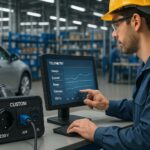The adoption of electric vehicles (EVs) has increased rapidly over the past few years, as people make the switch to cleaner, more sustainable transportation options. One of the key concerns for EV owners and potential buyers is the time it takes to charge their vehicles. With a variety of charging options available, Level 2 charging has become one of the most popular methods due to its balance between speed and convenience. This article will explore how fast Level 2 charging on an electric vehicle takes, its advantages, and factors that influence charging speed.

What is Level 2 Charging?
Before diving into the specifics of charging times, it’s important to understand what Level 2 charging is. Electric vehicle charging is categorized into three levels:
- Level 1 Charging: This is the slowest form of EV charging, using a standard 120-volt household outlet. It adds about 2-5 miles of range per hour of charging.
- Level 2 Charging: This is the most common public charging standard, using a 240-volt outlet. Level 2 chargers provide faster charging speeds compared to Level 1.
- DC Fast Charging (Level 3): This provides the fastest charging speeds, typically found along highways for long-distance travel.
Level 2 charging requires a 240-volt AC power supply, commonly found in homes and public locations. It’s the preferred choice for most EV owners due to its faster charging capabilities compared to Level 1. However, the exact time it takes to charge an EV on a Level 2 charger can vary based on several factors, such as battery size, the vehicle’s charging capabilities, and the power output of the charging station.
How Fast Does Level 2 Charging Really Charge Your EV?
On average, Level 2 chargers can deliver anywhere from 10 to 60 miles of range per hour of charging. However, this can vary widely depending on the factors mentioned earlier. To give you a clearer picture, let’s look at the typical times it takes to charge an EV using Level 2 charging.
Average Charging Time for Different EVs
The following table shows the typical charging times for various electric vehicles when using a Level 2 charger. These values assume the battery is nearly empty (0% charge) and the charging station provides an optimal 7.2 kW of power (common for home charging units).
| Electric Vehicle Model | Battery Size (kWh) | Charging Speed (miles per hour) | Estimated Charging Time (from 0% to 100%) |
|---|---|---|---|
| Tesla Model 3 Standard Range Plus | 54 kWh | 30 miles/hour | 5.5 hours |
| Chevrolet Bolt EV | 66 kWh | 25 miles/hour | 6 hours |
| Nissan Leaf | 40 kWh | 20 miles/hour | 6.5 hours |
| Audi e-tron | 95 kWh | 30 miles/hour | 8 hours |
| BMW i3 | 42.2 kWh | 22 miles/hour | 5.5 hours |
| Ford Mustang Mach-E | 75.7 kWh | 32 miles/hour | 7.5 hours |
Factors Affecting Level 2 Charging Speed
While the average charging speed provides a good baseline, several factors can influence the time it takes to charge an EV using Level 2 charging. Here’s a deeper look at some of these factors:
1. Battery Size
The size of the EV battery plays a significant role in how fast a vehicle can be charged. Larger batteries require more energy to charge, which can result in longer charging times. For example, the Audi e-tron, with its 95 kWh battery, will take longer to fully charge than the smaller Nissan Leaf with its 40 kWh battery.
2. Charger Power Output
Level 2 chargers can vary in their power output. Most home chargers typically offer around 7.2 kW, but some public chargers may offer 11 kW or even 22 kW. The higher the power output, the faster the vehicle can charge. A higher power output can also reduce charging time significantly, especially for EVs with larger battery capacities.
3. Vehicle’s Onboard Charger
The onboard charger (OBC) in an electric vehicle determines how much power the vehicle can accept from the charging station. Some vehicles are equipped with onboard chargers that can handle faster charging speeds, while others may be limited to slower speeds. For example, a vehicle with a 3.6 kW onboard charger can only charge at that rate, even if it’s plugged into a 7.2 kW charging station.
4. State of Charge (SOC)
The current state of charge (SOC) of the battery when you begin charging plays an important role in determining how long it will take to charge. If the battery is almost empty, it will charge more quickly in the early stages. However, charging tends to slow down as the battery nears full capacity. This phenomenon is known as “tapering,” where charging slows down as the battery reaches higher SOC levels to prevent overcharging and ensure safety.
5. Temperature
The ambient temperature can also affect charging speeds. Extremely cold or hot weather can slow down the charging process as batteries tend to perform less efficiently in extreme conditions. In colder temperatures, the battery management system may limit the charge rate to prevent damage to the battery cells. This can lead to longer charging times in winter months.
6. Charging Infrastructure Quality
The quality and maintenance of the charging station can also impact charging speeds. Older or poorly maintained stations might not deliver the full power output advertised, leading to slower charging speeds. Choosing reliable, well-maintained charging stations ensures a faster charging experience.
Comparing Level 2 Charging to Other Charging Levels
While Level 2 chargers are the most commonly used charging method for most EV owners, it’s helpful to compare them with other charging levels to understand the full spectrum of charging options.
Level 1 Charging vs. Level 2 Charging
Level 1 charging uses a standard 120-volt household outlet and is much slower than Level 2 charging. A typical Level 1 charger provides about 4-5 miles of range per hour of charging. For example, if you have a 40 kWh battery, using Level 1 charging, it would take more than 30 hours to fully charge the vehicle. In comparison, a Level 2 charger could complete the same task in less than 7 hours.
DC Fast Charging
DC fast charging is the fastest option for EV owners who need to charge quickly. With charging speeds that can range from 50 kW to over 150 kW, DC fast chargers can charge an EV to 80% in as little as 30 minutes. However, these chargers are typically found along highways or in public charging networks, not at home. While DC fast charging is much quicker than Level 2 charging, it’s not always suitable for everyday use due to the wear and tear it can place on the battery over time.
How to Maximize Level 2 Charging Efficiency
To make the most of your Level 2 charging experience, there are a few tips to keep in mind:
- Choose the Right Charging Station: Select a charger with the highest available power output, especially if you have a larger battery or if you need a faster charge.
- Optimize Charging Time: If you don’t need a full charge, consider charging for a shorter time to avoid the slow-down effect as the battery nears full capacity.
- Use Smart Charging Features: Many modern charging stations come with smart features that allow you to schedule charging during off-peak hours, potentially saving you money on electricity costs.
- Maintain Your Battery: Properly maintain your EV’s battery health by avoiding deep discharges (0% charge) and overcharging.
Conclusion
Level 2 charging provides a good balance between charging speed and convenience, making it the ideal solution for most electric vehicle owners. While the charging times can vary depending on several factors, including the vehicle’s battery size, charger output, and other variables, Level 2 charging typically offers 10 to 60 miles of range per hour of charging. By understanding the factors that influence charging times, you can make the most of your Level 2 charger and ensure a reliable charging experience.
As the demand for electric vehicles continues to grow, and the charging infrastructure continues to expand, Level 2 charging will remain a crucial part of the EV ecosystem. Whether you’re charging at home or using public stations, understanding how fast Level 2 charging can work for you will help you get the most out of your electric vehicle.




